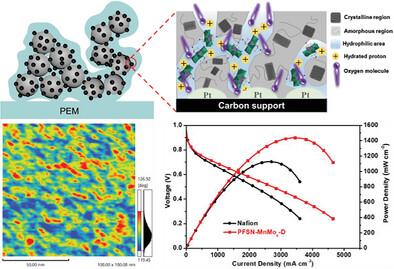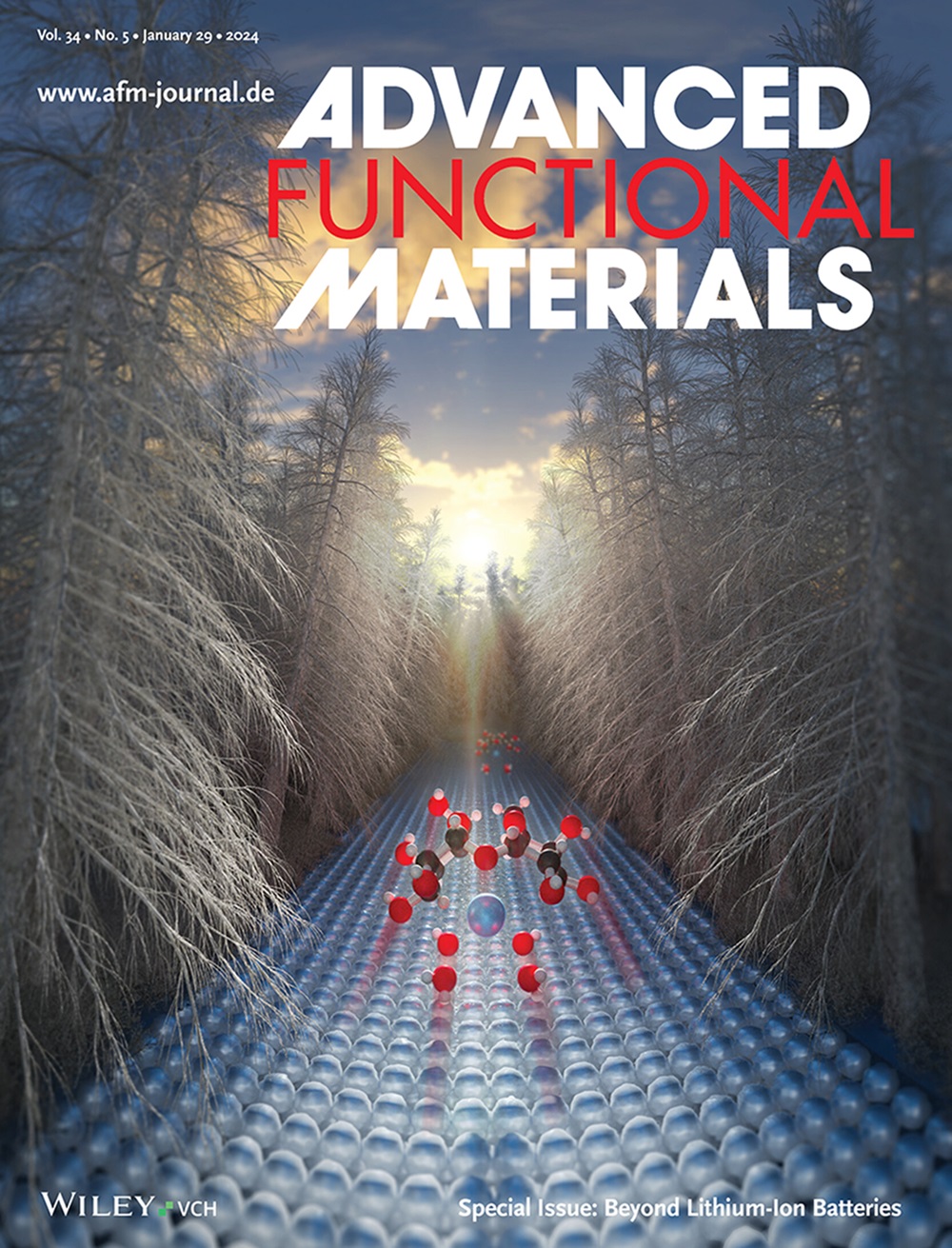A Highly Hygroscopic, Weakly Adsorbable, and Peroxide Scavenging Ionomer for Low-Pt Proton Exchange Membrane Fuel Cells
IF 18.5
1区 材料科学
Q1 CHEMISTRY, MULTIDISCIPLINARY
引用次数: 0
Abstract
An ionomer strategy is introduced to deal with two major performance-limiting issues for the proton exchange membrane fuel cells (PEMFCs) operating under low platinum (Pt) and low humidity. Specifically, the highly hydrophilic multiple-valence Anderson-type polyoxometalate (POM) cluster, [MnMo6O18(OH)6]3−, is chosen to covalently graft the perfluorinated polymer, substituting for sulfonate groups as proton carriers in perfluorosulfonic acid (PFSA). The structural and electrochemical characterizations indicate that this POM cluster, with large size, charges delocalization among multiple terminal oxygen atoms, and high hygroscopicity, can prevent the ionomer adsorption, which is believed to induce dense backbone crystallization to hinder O2 permeation at Pt/PFSA interface, and lead to ionomer assemblies with large and well-connected hydrophilic domains, which are recognized as the channels for efficient oxygen transport as well as proton conduction. Besides, the involvement of redox Mn ions in POM clusters makes the ionomer have capability to scavenge peroxides, which are known as the major chemical agents to degrade the MEA components. Consequently, fuel-cell cathodes using the POM-grafted ionomers exhibit significantly lower local O2 transport resistance and higher proton conductivity as compared with the PFSA-based electrodes; and accordingly, the fuel cells exhibit much-increased output performance at 50% relative humidity and impressive performance stability.

用于低铂质子交换膜燃料电池的高吸湿性、弱吸附性和过氧化物清除性离子聚合物
针对质子交换膜燃料电池(PEMFC)在低铂(Pt)和低湿度条件下运行的两大性能限制问题,介绍了一种离子聚合物策略。具体来说,该研究选择了高亲水性多价安德森型多氧金属盐(POM)簇[MnMo6O18(OH)6]3-来共价接枝全氟聚合物,以取代全氟磺酸(PFSA)中作为质子载体的磺酸基团。结构和电化学特性研究表明,这种 POM 簇具有大尺寸、多个末端氧原子间电荷分离和高吸湿性等特点,可以阻止离子体吸附,而离子体吸附被认为会诱导致密的骨架结晶,从而阻碍 Pt/PFSA 界面的氧气渗透,并导致离子体集合体具有大尺寸且连接良好的亲水域,而亲水域被认为是高效氧气传输和质子传导的通道。此外,氧化还原锰离子在 POM 团簇中的参与使离子聚合物具有清除过氧化物的能力,而众所周知,过氧化物是降解 MEA 成分的主要化学介质。因此,与基于 PFSA 的电极相比,使用 POM 接枝离子聚合物的燃料电池阴极具有更低的局部氧气传输电阻和更高的质子传导性;因此,燃料电池在 50% 相对湿度下的输出性能大大提高,性能稳定性也令人印象深刻。
本文章由计算机程序翻译,如有差异,请以英文原文为准。
求助全文
约1分钟内获得全文
求助全文
来源期刊

Advanced Functional Materials
工程技术-材料科学:综合
CiteScore
29.50
自引率
4.20%
发文量
2086
审稿时长
2.1 months
期刊介绍:
Firmly established as a top-tier materials science journal, Advanced Functional Materials reports breakthrough research in all aspects of materials science, including nanotechnology, chemistry, physics, and biology every week.
Advanced Functional Materials is known for its rapid and fair peer review, quality content, and high impact, making it the first choice of the international materials science community.
 求助内容:
求助内容: 应助结果提醒方式:
应助结果提醒方式:


